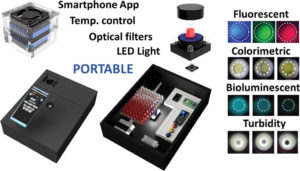
The quantitative detection of different molecular targets is of utmost importance for a variety of human activities, ranging from healthcare to environmental studies. Bioanalytical methods have been developed to solve this and to achieve the quantification of multiple targets from small volume samples. Generally, they can be divided into two different classes: point of care (PoC) and laboratory-based approaches. The former is rapid, low-cost, and user-friendly; however, the majority of the tests are semiquantitative, lacking in specificity and sensitivity. On the contrary, laboratory-based approaches provide high sensitivity and specificity, but the bulkiness of experimental instruments and complicated protocols hamper their use in resource-limited settings. In response, here we propose a smartphone-based device able to support laboratory-based optical techniques directly at the point of care. Specifically, we designed and fabricated a portable microplate reader that supports colorimetric, fluorescence, luminescence, and turbidity analyses. To demonstrate the potential of the device, we characterized its analytical performance by detecting a variety of relevant molecular targets (ranging from antibodies, toxins, drugs, and classic fluorophore dyes) and we showed how the estimated results are comparable to those obtained from a commercial microplate reader. Thanks to its low cost (<$300), portability (27 cm [length] × 18 cm [width] × 7 cm [height]), commercially available components, and open-source-based system, we believe it represents a valid approach to bring high-precision laboratory-based analysis at the point of care.